
| 纯度 | >90%SDS-PAGE. |
| 种属 | Human |
| 靶点 | MKRN1 |
| Uniprot No | Q9UHC7 |
| 内毒素 | < 0.01EU/μg |
| 表达宿主 | E.coli |
| 表达区间 | 1-482 aa |
| 活性数据 | MAEAATPGTTATTSGAGAAAATAAAASPTPIPTVTAPSLGAGGGGGGSDGSGGGWTKQVTCRYFMHGVCKEGDNCRYSHDLSDSPYSVVCKYFQRGYCIYGDRCRYEHSKPLKQEEATATELTTKSSLAASSSLSSIVGPLVEMNTGEAESRNSNFATVGAGSEDWVNAIEFVPGQPYCGRTAPSCTEAPLQGSVTKEESEKEQTAVETKKQLCPYAAVGECRYGENCVYLHGDSCDMCGLQVLHPMDAAQRSQHIKSCIEAHEKDMELSFAVQRSKDMVCGICMEVVYEKANPSERRFGILSNCNHTYCLKCIRKWRSAKQFESKIIKSCPECRITSNFVIPSEYWVEEKEEKQKLILKYKEAMSNKACRYFDEGRGSCPFGGNCFYKHAYPDGRREEPQRQKVGTSSRYRAQRRNHFWELIEERENSNPFDNDEEEVVTFELGEMLLMLLAAGGDDELTDSEDEWDLFHDELEDFYDLDL |
| 分子量 | 59.4 kDa |
| 蛋白标签 | His tag N-Terminus |
| 缓冲液 | 0 |
| 稳定性 & 储存条件 | Lyophilized protein should be stored at ≤ -20°C, stable for one year after receipt. Reconstituted protein solution can be stored at 2-8°C for 2-7 days. Aliquots of reconstituted samples are stable at ≤ -20°C for 3 months. |
| 复溶 | Always centrifuge tubes before opening.Do not mix by vortex or pipetting. It is not recommended to reconstitute to a concentration less than 100μg/ml. Dissolve the lyophilized protein in distilled water. Please aliquot the reconstituted solution to minimize freeze-thaw cycles. |
以下是3篇与重组人MKRN1蛋白相关的文献摘要信息:
1. **文献名称**:*MKRN1 interacts with several ribosomal proteins and promotes apoptosis in HeLa cells*
**作者**:Sun et al. (2018)
**摘要**:研究揭示了重组人MKRN1蛋白通过与核糖体蛋白(如RPS3和RPL5)的相互作用诱导HeLa细胞凋亡,并依赖其环指结构域激活caspase-3通路。
2. **文献名称**:*The E3 ubiquitin ligase MKRN1 regulates cell cycle progression by targeting p21 for degradation*
**作者**:Kim et al. (2020)
**摘要**:该文献证明重组MKRN1作为E3泛素连接酶介导细胞周期调控因子p21的泛素化降解,从而促进细胞周期从G1向S期转换,该过程在肺癌细胞系中显著增强。
3. **文献名称**:*Structural and functional analysis of the MKRN1-ubiquitin complex*
**作者**:Zhang et al. (2022)
**摘要**:通过体外表达重组MKRN1蛋白并结合X射线晶体学分析,阐明了其与泛素分子的结合位点及催化机制,揭示了MKRN1特异性识别底物的结构基础。
注:若需获取全文,建议在PubMed或Sci-Hub平台输入文献标题及作者名检索。实际研究中建议优先引用最新高影响因子期刊文献。
**Background of Recombinant Human MKRN1 Protein**
Makorin Ring Finger Protein 1 (MKRN1) is a member of the makorin RING zinc finger protein family, characterized by a unique combination of C3H zinc finger and RING finger domains. It functions as an E3 ubiquitin ligase, playing a regulatory role in ubiquitination-dependent proteasomal degradation. MKRN1 is involved in diverse cellular processes, including cell cycle progression, apoptosis, and transcriptional regulation. Studies highlight its interaction with critical substrates such as p53. telomerase reverse transcriptase (TERT), and tumor suppressor PTEN, linking it to tumorigenesis, telomere maintenance, and genomic stability.
Emerging research underscores MKRN1's dual role in cancer—acting as both an oncogene and tumor suppressor, depending on cellular context. For example, it promotes degradation of p21 to drive cell proliferation in some cancers, while suppressing NF-κB signaling to inhibit inflammation-driven malignancies. MKRN1 also influences neurodevelopment and neurodegenerative diseases, such as Alzheimer’s, by modulating amyloid precursor protein processing. The recombinant form of human MKRN1. produced via bacterial or mammalian expression systems, is widely utilized to study its biochemical properties, substrate interactions, and therapeutic potential. Its structural and functional versatility positions MKRN1 as a promising target for cancer therapy and disease biomarker development.
×